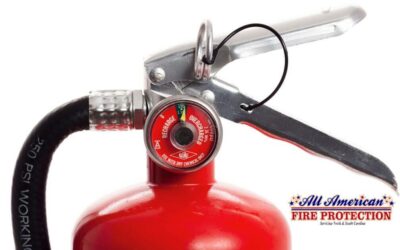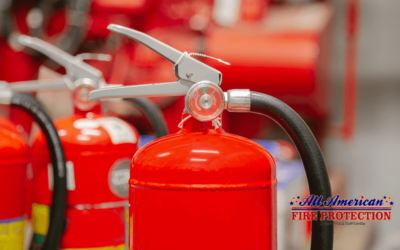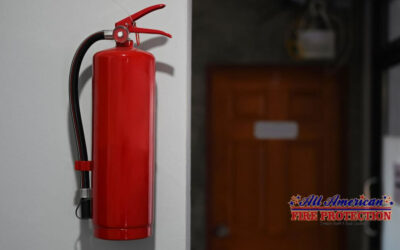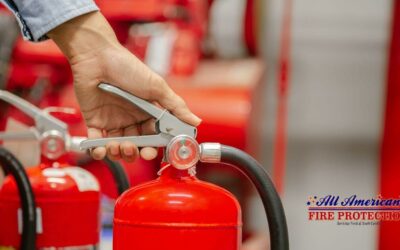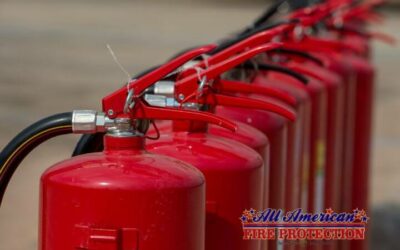Understanding the Importance of Regular Fire Extinguisher Inspections
The vigilance of routinely inspecting home fire extinguishers cannot be overstated, as it is a critical component of a household’s fire safety strategy. These inspections are not merely a formality; they are a proactive step towards ensuring that, in the heat of an emergency, your fire extinguisher will function as expected. With time, these devices may experience a range of issues, such as pressure degradation or seal erosion, which could critically hinder their performance. All American Fire Protection provides comprehensive services related to fire extinguishers, including regular inspections and maintenance, to ensure they remain in optimal working condition.
Regular inspections also serve an educational purpose, reinforcing the knowledge of how and when to use these devices. They can uncover hidden defects that might not be immediately obvious, like obstructed nozzles, that could thwart the extinguisher’s effectiveness. Furthermore, staying current with inspection schedules is crucial for compliance with the manufacturer’s guidelines and local fire regulations, which may influence warranty and insurance considerations.
By committing to routine inspections, homeowners gain invaluable peace of mind, fortified by the knowledge that they are well-prepared to defend their property and, more importantly, safeguard their families against the threat of fire.
Inspection Frequency: Guidelines and Best Practices
Adhering to a systematic inspection timetable for home fire extinguishers is essential for their dependability in a fire emergency. The National Fire Protection Association (NFPA) advises that fire extinguishers be visually examined on a monthly basis. This routine check involves a quick survey to confirm that the extinguisher is both visible and in operable condition.
Manufacturer’s Recommendations and Compliance
Following the manufacturer’s instructions is critical, as each fire extinguisher may have unique requirements for maintenance intervals. User manuals are provided with each model, detailing the necessary steps to preserve the extinguisher’s functionality and warranty.
Professional Inspection Intervals
In addition to monthly checks, it is advisable to engage a certified fire protection specialist for an in-depth review annually. This comprehensive evaluation delves into the mechanics and contents of the extinguisher to ensure it is primed for action. These yearly assessments are often documented, fulfilling local fire code and insurance policy prerequisites.
For certain extinguishers, such as those containing dry chemical agents, the NFPA mandates a detailed internal review every six years by a professional. This is to prevent issues like agent compaction, which can impede the extinguisher’s discharge in critical situations.
Steadfast adherence to these inspection frequencies, while keeping in line with manufacturer and regulatory directives, is the bedrock of ensuring that your fire extinguisher remains ready to protect your home and those within it.
Manufacturer’s Recommendations and Compliance
Adhering to the manufacturer’s guidelines is paramount for the proper functioning and longevity of fire extinguishers. These guidelines, often found in the user manual or on the unit’s label, provide invaluable information on storage conditions, inspection schedules, and maintenance procedures tailored to the specific model of the extinguisher. Following these instructions not only ensures the device remains in working order but also preserves the validity of its warranty.
Neglecting the manufacturer’s advice could lead to a voided warranty, emphasizing the necessity of consulting and abiding by the provided recommendations. This is particularly crucial for the inspection and servicing timelines that are unique to each type of extinguisher.
Moreover, local fire safety regulations and insurance policies may mandate adherence to the manufacturer’s guidelines. Compliance is not merely a best practice—it’s a legal and insurance imperative.
Manufacturers might also stipulate when an extinguisher requires professional servicing or replacement. Such directives are essential for establishing a maintenance plan that guarantees the extinguisher’s readiness in an emergency.
By aligning with the manufacturer’s maintenance recommendations and integrating them with prevailing industry standards and regulations, homeowners can ensure their fire extinguishers are primed for effective and safe operation.
Professional Inspection Intervals
While homeowners are encouraged to conduct regular visual checks of their fire extinguishers, a professional inspection is a more thorough evaluation that is recommended on an annual basis by the National Fire Protection Association (NFPA). These detailed assessments delve into the extinguisher’s mechanical integrity and are best performed by certified fire protection technicians.
A technician’s examination extends beyond a cursory glance, scrutinizing the extinguisher’s hose, nozzle, and other components for any deterioration that could hinder its performance. They will also assess the condition of safety seals and tamper indicators to confirm the device has not been previously used or compromised, ensuring its readiness for action.
The pressure gauge is another critical checkpoint, with technicians verifying that the needle points within the safe operating range. They may also weigh the extinguisher to identify any leakage or loss of extinguishing agent and inspect the agent itself for any signs of settling or caking that could obstruct its discharge.
Furthermore, a comprehensive review of the valve and shell for damage or corrosion is conducted, with meticulous documentation of the findings. This record is not only a testament to the device’s maintenance history but may also be required for compliance with local fire codes, insurance stipulations, and warranty preservation.
The frequency of these professional inspections can vary, influenced by factors such as local regulations, the extinguisher’s environment, and the manufacturer’s specific guidelines. When faced with varying standards, the rule of thumb is to default to the most stringent requirement to ensure the highest level of readiness and legal conformity.
Through these systematic professional evaluations, the dependability of home fire extinguishers is affirmed, providing peace of mind that they will function as expected in the event of a fire.
Conducting Your Own Visual Inspections
As a homeowner, taking the initiative to visually inspect your fire extinguishers each month is a proactive step towards ensuring your safety. This simple yet vital routine aids in the early detection of any anomalies that could compromise the device’s functionality. No special equipment or extensive training is necessary to perform these checks.
Begin by verifying that the extinguisher is in its designated location, unobstructed and within easy reach. The label should be facing forward, with instructions clear and readable, to facilitate swift action if a fire arises.
Moving on, examine the pressure gauge. The needle should rest within the green zone, signifying that the extinguisher is charged and ready for use. This is a critical detail, as a fully operational extinguisher is your first line of defense in an emergency.
Inspect the extinguisher for any physical damage, such as dents, corrosion, or signs of leakage. These could be indicative of underlying issues that might impair its effectiveness. If the extinguisher is equipped with a hose and nozzle, ensure they are undamaged and clear of obstructions.
Confirm that the locking pins and tamper seals are intact, which we’ve touched on in the ‘Seals and Tamper Indicators’ section. This is essential as it indicates the extinguisher has remained unused and unaltered. Additionally, remove any dirt or debris that could inhibit the device’s function, and check the maintenance tag to ensure the unit has been professionally inspected within the last year. If this is not the case, arrange for a professional inspection without delay.
By incorporating these monthly inspections into your routine, you are taking an active role in maintaining the readiness of your fire extinguisher, complementing the thorough evaluations conducted by professionals.
Visual Checklist: Damage, Pressure, and Accessibility
A systematic approach to your monthly fire extinguisher inspection can be facilitated by following a comprehensive checklist. Here’s what to keep an eye out for:
- Damage: Carefully assess the extinguisher for any signs of wear or damage, including the body and all components such as the hose or nozzle. Any imperfections could potentially hinder the device’s operation.
- Pressure: Confirm that the pressure gauge indicates the extinguisher is within the optimal operating range, typically marked by a green zone. A needle outside this area suggests the need for professional servicing.
- Accessibility: The extinguisher should be readily accessible, mounted properly, and its location should be common knowledge among all occupants of your home. Ensure there are no obstacles in the way that could delay its retrieval during an emergency.
- Visibility: The instructions on the extinguisher should be clean, clear, and easily readable, ensuring that anyone can reference them quickly if needed.
- Tamper Seals and Pins: Check that the tamper seal is unbroken and the safety pin is securely in place. Any discrepancies here could indicate prior use or tampering, necessitating professional examination.
- Cleanliness: Inspect the extinguisher for any foreign substances that could affect its operation and clean as needed.
This checklist not only serves as a guide for your monthly inspections but also reinforces the importance of vigilance in fire safety. Should you encounter any issues beyond your capacity to address, or if you suspect the extinguisher is not functioning optimally, do not hesitate to seek the expertise of a fire safety professional. Your diligence in these inspections is a critical component in maintaining the efficacy of your fire safety plan.
Seals and Tamper Indicators
Ensuring the integrity of your fire extinguisher begins with a close examination of its seals and tamper indicators. These components are crucial for verifying that the unit remains untouched and primed for action. As you conduct your routine check, pay attention to the following elements:
-
Tamper Seals: Look for the intactness of the tamper seal, which is a small yet significant device that secures the extinguisher’s pin. An intact seal signifies that the unit has not been previously activated or compromised. Conversely, a broken seal may indicate prior use or tampering, even absent any signs of discharge.
-
Safety Pins: The presence and condition of the safety pin are equally telling. This pin, which prevents unintended activation, should be firmly in place. If you find the pin missing or suspect it has been manipulated, this could point to prior use of the extinguisher.
-
Inspection Tags: While not a direct indicator of tampering, the inspection tag offers a history of the extinguisher’s maintenance and servicing. This log is essential for tracking whether the unit has been inspected and serviced as per the recommended schedule.
Should you find any issues with the tamper seal or safety pin, or if the inspection tag suggests missed maintenance, it’s critical to take the extinguisher out of service and seek a professional evaluation. An extinguisher that has been compromised may fail when you need it most, so prompt action is necessary to ensure the safety of your home.
Educating household members about the importance of these indicators is also key to preventing inadvertent tampering. By familiarizing everyone with what to look for during visual inspections, you help maintain the extinguisher’s readiness for emergencies.
Upon detecting any irregularities with these protective measures, immediate steps should be taken to address potential safety concerns. Keeping these components intact is a testament to the extinguisher’s preparedness for any fire-related emergency.
Professional Inspection: A Closer Look
A professional fire extinguisher inspection delves deeper than the homeowner’s visual assessment, employing specialized knowledge and tools to ensure the unit meets all safety and operational standards.
Certified technicians perform a series of rigorous evaluations during a professional inspection, including:
-
Verification of Tags and Records: The technician will examine and update the maintenance tag, confirming that the extinguisher’s service history is current.
-
Physical Examination: A thorough inspection for any signs of physical damage, such as corrosion or dents, is conducted, as these can impact the extinguisher’s functionality.
-
Discharge Test: To ensure proper operation, a controlled discharge test may be performed to confirm that the extinguishing agent is released as expected.
-
Internal Inspection: Technicians may inspect the interior of the extinguisher for signs of corrosion or obstruction that aren’t visible externally.
-
Weight Check: By weighing the extinguisher, the technician can verify that it contains the correct amount of agent, with any discrepancies potentially indicating a leak or partial discharge.
-
Pressure Tests: Advanced equipment is used to ensure the extinguisher maintains its pressure, which is vital for its operation.
-
Handle and Lever Checks: All operational controls are tested to ensure they function smoothly and reset correctly.
-
Nozzle and Hose Inspections: The discharge mechanisms are examined for any blockages or wear that could hinder the agent’s release.
-
Safety Seals and Pin Inspections: The technician will conduct a detailed assessment of the seals and pins to ensure their integrity.
The nature of a professional inspection can vary based on the type of extinguisher and local regulations, but it is an essential component of fire safety maintenance. Following the inspection, a service tag will be provided, documenting the date and details of the service, and serving as a compliance record and reminder for the next inspection.
Professional inspections are critical to the life cycle of a fire extinguisher, ensuring not only its operational readiness but also its effectiveness and safety. These inspections complement, rather than replace, regular visual checks by homeowners, together forming a comprehensive approach to fire safety.
Technician’s Inspection Procedures
A technician’s approach to inspecting a fire extinguisher is comprehensive and meticulous, ensuring that each device is ready to function in an emergency. The process includes:
-
Initial Assessment: This step extends beyond the homeowner’s visual check, as the technician scrutinizes the extinguisher for any overt signs of wear or damage that could compromise its functionality.
-
Mechanical Parts Check: The technician meticulously examines all moving components, such as the handle, lever, pin, and nozzle. The focus is on their operational integrity and the ease with which they perform their functions.
-
Pressure Verification: Utilizing specialized tools, the technician measures the extinguisher’s pressure to confirm it aligns with the manufacturer’s specifications, as highlighted in the ‘Professional Inspection: A Closer Look’ section.
-
Weighing and Checking Contents: By weighing the extinguisher, the technician can determine if the extinguishing agent is at the correct level, which is crucial for effective performance.
-
Internal Examination: Depending on necessity, the technician may employ scopes or disassemble the unit to inspect the interior for corrosion or other issues not visible from the outside.
-
Expiry Date Check: The technician ensures that the extinguisher and its components are within their service life, taking into account the potential degradation of materials over time and under various environmental conditions.
-
Conductivity Testing: For extinguishers like CO2 models, the technician conducts conductivity tests on the discharge nozzle to prevent any static-induced shocks during use.
-
Discharge Test (if applicable): Depending on the maintenance schedule or specific guidelines, the extinguisher may be discharged to confirm that it expels its contents effectively and is fully operational.
-
Seal and Re-tagging: To finalize the inspection, the extinguisher is fitted with a new tamper seal and tagged with the inspection date, the technician’s signature, and the date for the next inspection or service.
These steps are crucial for ensuring that fire extinguishers remain reliable and effective. Homeowners are encouraged to engage qualified professionals for these thorough inspections.
Service Documentation
Service documentation is a vital component of fire extinguisher upkeep, providing a detailed account of each unit’s condition and compliance with safety regulations. The documentation includes:
-
Inspection Tags: These tags are affixed to the extinguisher after a professional service, noting the date of service, the technician’s signature, and when the next service is due.
-
Service Report: A comprehensive report accompanies the inspection tag, summarizing the inspection findings, any corrective actions taken, and recommendations for future servicing or replacement.
-
Maintenance Records: Both the service provider and the extinguisher owner should keep these records, which chronicle the history of inspections, tests, recharges, and replacements, aiding in warranty tracking and scheduled replacements.
-
Certification Certificate: Following specific tests, such as hydrostatic testing, a certificate may be issued to confirm that the extinguisher meets the required standards.
-
Instruction and Advisory Notices: Documentation may also include updates from the manufacturer or the service provider regarding recalls, changes in fire codes, or new maintenance best practices.
Maintaining a full set of service documentation ensures readiness for safety audits, provides proof of proper maintenance, and offers a clear record of each extinguisher’s status for emergency preparedness. It is an integral part of a home or business’s fire safety protocol.
Maintaining Your Fire Extinguisher
Ensuring the operational readiness of your fire extinguisher is paramount for effective emergency response. Maintenance encompasses a series of actions:
-
Routine Checks: In addition to professional evaluations, perform regular visual checks. This proactive approach can help identify issues such as corrosion or wear and tear. For specifics, see the earlier ‘Visual Checklist: Damage, Pressure, and Accessibility’ section.
-
Prompt Response to Issues: Upon discovering any irregularities, such as a compromised seal or a pressure gauge reading outside the operable range, immediate measures should be taken. This may involve professional servicing or, in some cases, complete replacement of the unit.
-
Careful Handling: Treat fire extinguishers with respect to prevent inadvertent damage. Mishandling can compromise the device’s integrity and effectiveness.
-
Storage Environment: Adhere to the manufacturer’s guidelines for storage, avoiding extreme temperatures and corrosive environments that could degrade the extinguisher’s components.
-
Unobstructed Access: Ensure that the location of your fire extinguisher is both visible and accessible, with signage if necessary. Obstructions can critically delay deployment in an emergency.
-
Recharging Necessity: Following any level of use, it is imperative to have the extinguisher recharged, a process detailed in the ‘Post-Use Recharging and Part Replacement’ section.
-
Authentic Parts: In the event of part replacement, insist on components sanctioned by the extinguisher’s manufacturer to maintain optimal functionality and safety.
Adherence to these maintenance protocols will maximize the efficacy and lifespan of your fire extinguisher, a crucial ally in safeguarding lives and property.
Post-Use Recharging and Part Replacement
Once a fire extinguisher has been activated, it’s essential to restore it to full capacity without delay. The steps for recharging and replacing parts are as follows:
-
Professional Recharging: A certified technician should replenish the extinguishing agent and re-pressurize the canister to the manufacturer’s specifications, ensuring readiness for any subsequent emergencies.
-
Component Upgrades: Should an inspection uncover worn or defective components, such as seals or the trigger mechanism, these should be promptly replaced with parts that meet the manufacturer’s standards.
-
Verification Post-Recharge: After the recharging process, the unit should undergo a thorough inspection to confirm its functionality and to address any further maintenance needs.
-
Documentation Updates: Record the maintenance activity, including recharging and part replacement, in the service log as outlined in the ‘Service Documentation’ section. A current inspection tag should be affixed to the extinguisher, reflecting the recent service.
By following these steps after each use, you help ensure the reliability of your fire extinguisher and its preparedness to protect in the event of a fire. Engaging with fire safety experts for these services is crucial for adherence to safety regulations and warranty preservation.
Hydrostatic Testing Requirements
Hydrostatic testing stands as a critical safeguard in fire extinguisher maintenance, designed to ensure that the canister can withstand operational pressures. This procedure involves subjecting the extinguisher to higher-than-normal pressures to confirm its ability to securely contain its fire-suppressing agent.
-
Frequency: The schedule for hydrostatic testing varies by extinguisher type. Commonly, dry chemical and wet chemical extinguishers require this test every 12 years, while carbon dioxide and water-based models are tested every 5 years. Always consult the manufacturer’s guidelines and adhere to local codes to determine the precise timing for your extinguisher.
-
Process: The procedure begins with the extinguisher being depressurized and emptied. The valve is then detached, and the cylinder is filled with a non-compressible fluid, typically water. The technician applies pressure internally and monitors the cylinder’s expansion. After the pressure is released, the cylinder should revert to its original dimensions. Any failure to do so, or the presence of stress indicators, necessitates the replacement of the extinguisher.
-
Certification and Documentation: Successful hydrostatic testing leads to the extinguisher being dried, reassembled, and recharged. A certification label or stamp is then affixed to the extinguisher to indicate its compliance with safety standards, as detailed in the Service Documentation section.
-
Disposal of Failed Units: Extinguishers that fail hydrostatic testing are taken out of service and disposed of following specific environmental and safety protocols. It is imperative to avoid using or attempting to repair a failed extinguisher.
Only certified professionals should perform hydrostatic testing due to the risks involved. Homeowners are advised against attempting this test. Ensuring that your fire extinguisher undergoes timely hydrostatic testing is an essential component of its upkeep.
When to Replace or Dispose of Fire Extinguishers
Recognizing the appropriate time to replace or properly dispose of fire extinguishers is essential for upholding fire safety standards. There are several key indicators that signal when an extinguisher should be retired.
-
Expiry and Manufacturing Date: The age of an extinguisher can be determined by its manufacturing label. Most extinguishers are designed to last between 5 and 15 years. It’s advisable to replace any extinguisher that has reached the end of its service life.
-
After Use or Partial Discharge: If an extinguisher has been discharged, even partially, it should be serviced as soon as possible. Disposable models, or those that cannot be recharged, should be replaced promptly.
-
Regular Maintenance Failures: If a technician discovers issues during routine maintenance that cannot be rectified, or if repairs are not economically viable, the extinguisher should be replaced.
-
Corrosion or Structural Damage: Any signs of rust, corrosion, or damage that could compromise the extinguisher’s integrity are indications that it should be taken out of service.
-
Failed Testing: An extinguisher that does not pass hydrostatic or other maintenance tests is considered unsafe and should be disposed of immediately.
-
Obsolete Technology: Extinguishers that no longer meet current safety standards or contain prohibited substances should be updated to a compliant model.
-
Disposal Protocol: Consult local waste management services for the correct disposal method of an old or damaged extinguisher. Often, this involves taking the unit to a hazardous waste facility or a fire department. Improper disposal, such as discarding in regular trash, can pose safety risks and harm the environment.
Transitioning to a new fire extinguisher is a proactive step towards maintaining a safe environment. Adhere to environmental guidelines for the disposal of outdated units to ensure safety and compliance.
Replacement Indicators
To ensure your fire extinguisher remains a reliable safeguard, it’s crucial to recognize when it’s time for a replacement. Consider the following signs that your extinguisher may have reached the end of its service life:
-
Physical Damage: Compromises such as dents, leaks, or signs of rust and corrosion can impair an extinguisher’s functionality. Such damage not only poses operational risks but also safety hazards.
-
Pressure Gauge Concerns: An extinguisher whose pressure gauge persistently registers outside the recommended range, despite professional attention, is a candidate for replacement due to potential reliability issues.
-
Component Integrity: An extinguisher lacking essential components, including safety seals and pins, compromises its readiness and effectiveness. Such deficiencies necessitate immediate replacement.
-
Service History: Frequent repairs or outdated inspection tags suggest that an extinguisher may be beyond economical repair and would benefit from replacement.
-
Regulatory Compliance: Extinguishers that fail to meet current safety standards or are mismatched to the fire risks present should be replaced with models that ensure compliance and proper protection.
-
Post-Service Performance: Should an extinguisher fail to function correctly after professional servicing, this is a definitive sign that it’s time for a new unit.
-
Manufacturer Alerts: Stay informed about any recalls or advisories from the manufacturer that may impact the safety and operation of your extinguisher, as these may necessitate immediate replacement.
Regularly monitoring these factors will help maintain the readiness of your fire extinguishers, ensuring they are primed for action when the need arises.
Environmentally Safe Disposal
Proper disposal of fire extinguishers is not only a matter of environmental responsibility but also a legal requirement. When an extinguisher has served its purpose, follow these steps to dispose of it without harming the environment:
-
Local Guidelines: Begin by consulting with your local environmental agency or fire department to understand the specific disposal protocols in your area.
-
Depressurization: In certain cases, you may be instructed to release any remaining pressure in the extinguisher. This should be done with caution, in a ventilated space, and preferably under professional guidance.
-
Designated Facilities: Given their hazardous nature, fire extinguishers often need to be taken to specialized facilities equipped to handle such waste.
-
Recycling Opportunities: Parts of the extinguisher, like the metal body, may be recyclable. Specialized centers can safely process these components, ensuring that all materials are handled appropriately.
-
Expert Assistance: If you’re uncertain about the disposal process, don’t hesitate to reach out to a fire safety professional. They can either manage the disposal for you or direct you to a facility that can.
Adhering to these environmentally conscious disposal methods helps protect our planet while keeping our communities safe and compliant with regulations.


